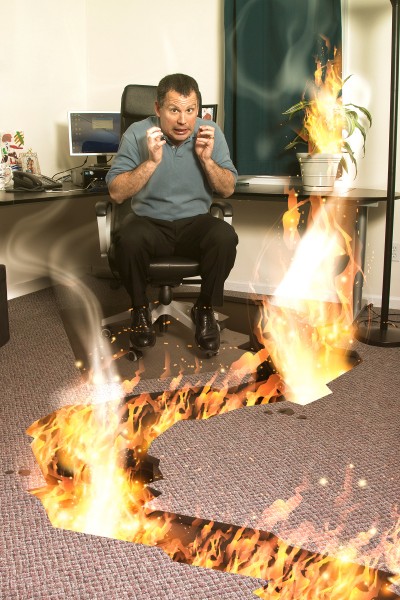All hell will break loose. You can count on it.

Every business, regardless of industry or size, will face a crisis. I’m not talking about a dip in cash flow or a pissed off client. I’m talking about something with the potential to generate unwanted public and media attention, disrupt operations and rock your business to the core. Best to be prepared.
Having a communication plan in place is like insurance. You hope you never need to use it, but it’s great to know it’s there if all hell breaks loose. I can’t possibly get into all the details of a solid crisis plan here, so we’ll stick to the top line and hope by the end of this you are pulling together your crisis preparedness team.
Keep it simple.
To succeed, a crisis plan can’t be complicated. If it’s a 200-page manual, no one will read it or remember what to do. It should be a checklist-based protocol. The goal is to make it easy to follow a logical order of tasks and responses during what could be a very emotional time.
Pin down corporate messaging.
It all starts with messaging. Having a well-prepared elevator speech that speaks to what you do well is essential. Key messages about company values, beliefs, commitments and mission should be woven into interviews during a crisis. Doing this effectively takes an understanding of basic interview techniques. And practice. (See “Identify and Train Spokespeople” below.)
Audit your vulnerability.
Some crises you can never anticipate—but most you can. When we develop a crisis communication plan for clients, we go through a process of scripting out the 7 to 10 events that could, at some point, result in a crisis. Talk to people in every aspect of your business from the loading dock to the C-suite. Ask them what might go wrong, and why. Then develop talking points around each topic that can be used regardless of the particular instance. For example, every manufacturing plant should have credible talking points about the company’s commitment to employee safety in the workplace.
Identify and train spokespeople.
When a crisis hits, there should be no question who is authorized to talk to the media. Determining this in advance is essential. Dealing with the media and addressing the public require skill and practice. Rehearse key messages. Practice interviewing techniques: Give a strong opening. Get key messages into the interview early. Bridge and deflect and block.
Set up a video camera so the spokesperson can run practice interviews in privacy. Then critique the results. If you need help, do a search for articles about interviewing. Consider hiring a company that specialize in interview training and public speaking.
Having a communication plan in place is like insurance. You hope you never need to use it, but it’s great to know it’s there if all hell breaks loose.
Establish the chain of communication.
Every employee in each rank of the organization should know whom to contact in the event of crisis. The CEO needs to be informed quickly—and with as few people as possible passing along the information. If it’s deemed a true crisis, the rest of the crisis communication team—usually the CEO, members of the executive team, the head of marketing/PR and legal counsel—need to convene ASAP.
Designate one lead person to direct and coordinate all aspects of the organization’s reaction to the crisis. Only the lead and back-up spokespeople are authorized to speak with the media and release information to the public. All other staff, board and committee members should be helpful to the media by connecting them with the spokespeople, but not provide any information.
Develop crisis-specific messaging.
After going through the vulnerability audit process, you should be largely prepared for the most likely crises. Now it’s time to get specific. “No comment” is never acceptable. It looks like you have something to hide. If the question cannot be answered due to a corporate policy (such as sharing personnel information) let the inquirer know that.
Provide the media with information that enables them to do their jobs and positions your company as helpful, transparent, responsive, solution-oriented and trusted. Develop factual, detailed messages that reflect the status of the crisis, the company response, and, if possible, proactive steps you’re taking to resolve the situation.
For example, in the event of a wide-scale identity theft at a major credit card company, messages like this resonate: “Protecting the privacy of our customers’ personal information is a top priority. We have launched a full-scale investigation and are cooperating fully with the FBI.”
Communicate openly but judiciously.
Designate one lead person to direct and coordinate all aspects of the organization’s reaction to the crisis.
In a previous life, I had a job as marketing director, and my boss, the VP of the division, took a decidedly opposite approach to crisis communication. He believed the best way to deal with the media was to tell them nothing. He shunned them, stalled, refused to answer questions, and hoped the problem would go away. This bred distrust and made the media want to dig deeper. It also damaged our ability to get positive press coverage. When a crisis did hit, the media knew they wouldn’t have a cooperative official source, so they went to unofficial sources for the story. The damage was magnified significantly because the facts weren’t straight and the corporate messaging was never delivered.
Never speculate. Stick to facts. Don’t be afraid to respectfully redirect a question. For example, if a reporter says, “I understand this may have been in inside job,” don’t fall for it. Simply restate the facts and your key messages. “We know that some 100,000 records were comprised. Protecting our customers’ privacy is top priority. Our investigation is underway and we are fully cooperating with the FBI.”
Don’t hesitate.
People often ask me when is the best time to let employees know what’s going on. My answer is “Before it happens.” Assume that everything you say will be reposted, retweeted and shared the world over in a blink.
When I worked with a leading university, the biggest crisis we ever had to deal started when a local radio station reported on a crime that had happened on campus. This lead to the local paper picking up the story. It went out on the wire. The next day I was fielding calls from the BBC in London. Mind you—that was 10 years ago. Today news like this travels in a Twitter-second. Best to be prepared for the worst.



